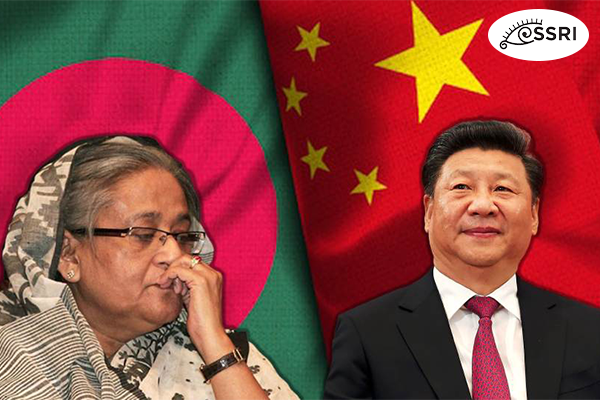In late April, the People’s Liberation Army (PLA) of China announced plans to conduct its first military exercises with Bangladesh in May. The exercise, named “Golden Friendship 2024,” will focus on UN peacekeeping counter-terrorism operations, including scenarios such as anti-hijacking on buses and the elimination of terrorist camps.
The PLA spokesperson emphasized that this joint training aims to enhance mutual understanding, deepen friendship, and promote practical exchanges and cooperation between the Chinese and Bangladeshi militaries.
This initiative comes amidst China’s concerns over Bangladesh’s proposed defense purchases from India under a US$500 million Line of Credit. It also addresses Bangladesh’s ongoing complaints about the subpar quality of Chinese defense equipment it has previously imported.
By engaging in these bilateral exercises, China aims to address and mitigate the reputational risks faced by its defense industries on the global stage.
Challenges with Chinese Military Equipment: Bangladesh’s Concerns
China has been a major supplier of military equipment to the Bangladesh Armed Forces, with Dhaka spending a substantial US$2.59 billion on Chinese defense equipment in the past decade. However, Bangladesh has encountered numerous issues with the quality and performance of this equipment.
Despite being a major arms supplier, China has faced international criticism for exporting malfunctioning and defective military hardware, straining the budgets of recipient countries and leaving them short of essential security assets.
The Chinese defense industry’s reliance on cloned technology has further exacerbated the problem. Much of the equipment they manufacture is based on outdated technology replicated from Western designs, raising concerns about reliability and effectiveness.
In recent years, Bangladesh has experienced technical problems with Chinese-supplied equipment across various branches of its military. The Bangladesh Air Force has reported issues with the F-7 fighter aircraft, including technical malfunctions and inaccuracies in radar systems. Problems have also arisen with radar accuracy on fighter aircraft, as well as difficulties with munition firing on K-8W aircraft, resulting in fatal accidents.
The Bangladesh Army has faced challenges with spare parts and maintenance for Main Battle Tanks (MBT 2000) procured from China, as well as issues with tank ammunition supply. Similarly, defects have been identified in Chinese naval platforms supplied to the Bangladesh Navy, including non-functioning radar and gun systems on frigates.
Furthermore, Bangladesh has encountered difficulties with Chinese submarines, which were found to be outdated soon after acquisition. Despite repeated requests for assistance, China has not provided adequate support.
Reports have also emerged of mistreatment of Bangladeshi personnel during training programs conducted by China, raising concerns about the quality of collaboration between the two countries.
In summary, despite significant investments in Chinese military equipment, Bangladesh has faced numerous technical, operational, and reliability issues, impacting its security capabilities and straining its military budget.
The Realities of China’s Arms Sales: Challenges and Concerns for Bangladesh
China’s role as a supplier of military equipment brings significant challenges for developing countries like Bangladesh, despite the allure of affordability and political ties. While initial promises may seem enticing, the reality often falls short, leaving recipient nations in precarious positions.
One of the foremost issues is the failure of Chinese military equipment to meet post-delivery standards, compromising security objectives and straining military budgets. Moreover, the lack of technological compatibility adds further complexity and cost to maintenance and operation.
A 2023 RAND Corporation report highlights the prohibitively expensive nature of acquiring replacement parts and addressing technological incompatibilities with Chinese military equipment for Bangladesh. Instances such as payment withholding due to multiple snags in supplied systems underscore ongoing challenges.
Transparency and accountability in Chinese defense contracts are also cited as concerns, with many countries experiencing poor after-sales support and rapid equipment deterioration. Despite these drawbacks, the allure of competitive pricing often leads developing nations to favor Chinese suppliers.
Complicated training procedures and inadequate contract evaluations contribute to escalating maintenance costs and difficulties in obtaining spare parts. While Chinese arms may initially appear cost-effective, the lack of comprehensive after-sale service support ultimately incurs additional expenses.
Furthermore, China’s dominance as a military equipment supplier in Bangladesh has led to apprehensions regarding the quality of supplies and defense pricing. As Bangladesh explores diversifying its defense acquisitions, including sourcing from India, Europe, and the US, Beijing endeavors to address these concerns.
In conclusion, while China remains an attractive source for military equipment due to pricing and political considerations, the realities of its arms sales present significant challenges and concerns for countries like Bangladesh.
Assessing China’s Military Equipment Exports: Challenges and Considerations
In recent years, China’s defense industry has faced scrutiny for exporting malfunctioning and defective military equipment, posing significant challenges for recipient countries and undermining their security objectives.
Nigeria’s experience with Chinese-made F-7 aircraft exemplifies these challenges, with technical problems leading to crashes and accidents. Similarly, Myanmar and Bangladesh have reported issues with radar accuracy and ammunition firing on Chinese-built aircraft, respectively.
Pakistan, a major importer of Chinese military equipment, has encountered problems with F-22P frigates and missile systems, highlighting concerns about technical issues and overall performance.
While China’s competitive pricing attracts customers, hidden costs arise when equipment malfunctions, especially due to technological incompatibility. Many recipient countries lack personnel trained to address these issues, leading to difficulties in acquiring replacement parts and reliance on third-party assistance.
China’s arms deals are primarily with developing countries, driven by profit and soft power motives. Its willingness to sell without political contingencies appeals to countries seeking alternatives to Western suppliers. Additionally, China dominates the “value arms” market, offering affordable options for counterterrorism operations and defense needs.
Despite its market dominance, China’s reputation for quality remains a concern. Data shows a decline in arms exports, indicating growing skepticism about the reliability of Chinese military equipment.
As affordability remains a priority for developing countries, they may continue to consider Chinese suppliers. However, concerns about long-term reliability and inadequate training and maintenance support could prompt them to seek alternatives.
In conclusion, while China’s military equipment offers affordability and functionality, recipient countries must weigh the risks of dependence on Chinese suppliers against the potential benefits.
Evaluating Risks in Procuring Chinese Military Equipment
While many Asian and Southeast Asian countries see China as a primary exporter of military arms, the allure of its military equipment often masks significant pitfalls and challenges for these allied nations.
Pakistan, considering the procurement of Chinese fifth-generation FC-31 Gyrfalcon stealth fighter aircraft, must take heed of past concerns about Chinese-produced assets. Complaints, ranging from technical issues in frigates to malfunctioning missile systems, highlight reliability issues.
Similarly, Nigeria and Myanmar have encountered technical problems with Chinese-made aircraft, necessitating substantial maintenance and repairs. Bangladesh also faced difficulties with Chinese-built aircraft shortly after delivery.
China’s strategy of offering affordable pricing and financing options may initially attract customers, but hidden costs emerge when equipment malfunctions. Lack of technological compatibility and accountability further compound challenges for recipient countries.
Recent data shows a decline in China’s arms exports, reflecting concerns about reliability and performance. Even Pakistan, dealing with mechanical problems with frigates, struggles with ineffective missile systems.
While affordability remains a key factor, recipient nations must weigh this against reliability concerns and deficiencies in maintenance and training. Dependence on Chinese equipment might not be sustainable if reliability issues persist.
China’s arms deals with developing countries are driven by profit and soft power motives. However, concerns about human rights and financial credibility may impact eligibility for Western suppliers, making China an appealing alternative.
As recipient countries aim to strengthen their hardware and supplies, they must carefully assess the long-term reliability and support provided by Chinese suppliers. The onus is on China’s allies to navigate these risks effectively.
Summary
The joint military exercise between China and Bangladesh, named “Golden Friendship 2024,” signifies a significant collaboration aimed at enhancing mutual understanding and practical cooperation. However, underlying concerns persist regarding Bangladesh’s dissatisfaction with the quality of Chinese defense equipment, despite substantial investments.
Reports of technical issues with Chinese-made military assets, including aircraft and naval platforms, raise questions about reliability and performance. While China’s competitive pricing attracts customers, hidden costs emerge when equipment malfunctions, leading to challenges in maintenance and operation.
Concerns about long-term reliability and inadequate support prompt recipient countries to reassess their dependence on Chinese suppliers. As they weigh the risks against the benefits, the future of military equipment procurement lies in navigating these challenges effectively.
Reference
- https://english.khabarhub.com/2024/12/355283/
- https://businesspostbd.com/world/Asia/chinas-sale-of-flawed-military-equipment-to-allies-pose-serious-challenges
- https://timesofindia.indiatimes.com/world/china/chinas-arms-exports-face-sharp-decline-due-to-defective-quality-unreliable-performance-analysts/articleshow/103619727.cms
- https://nepal.shafaqna.com/NE/AL/2791363
- https://www.wionews.com/south-asia/bangladesh-faces-quality-issues-with-chinese-military-equipment-report-431351
- https://nepal.shafaqna.com/NE/AL/2791363




